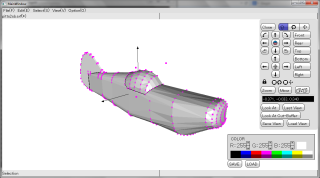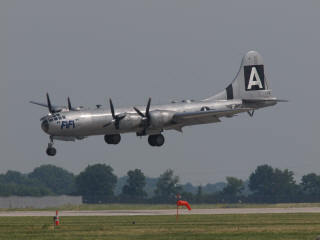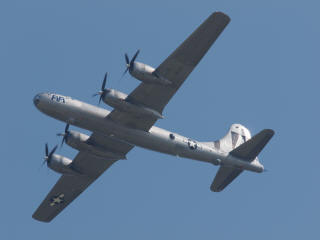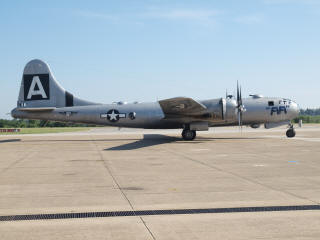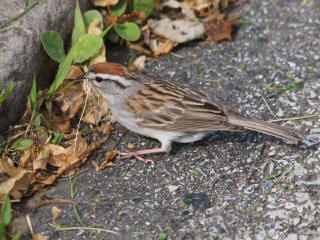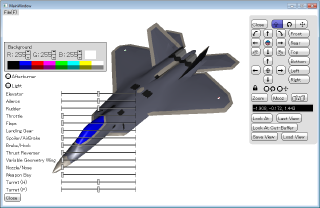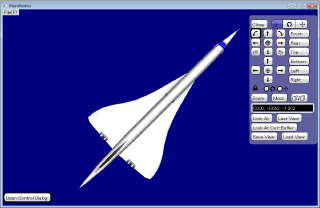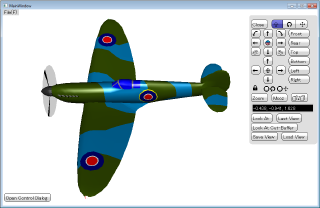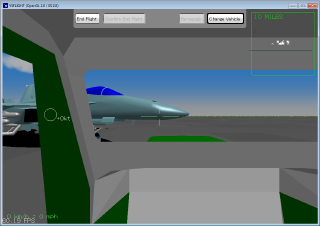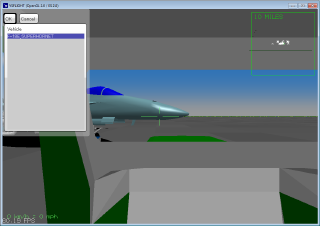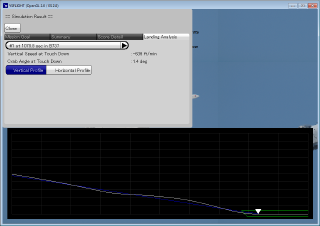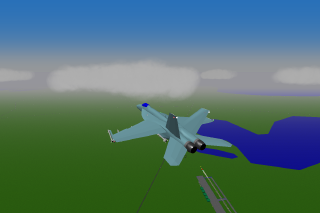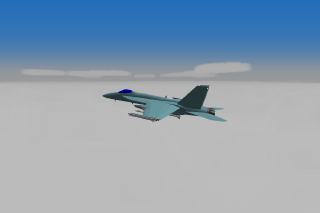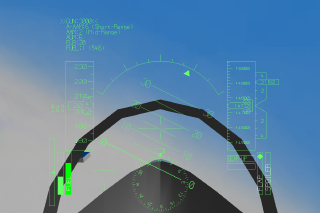| ysflight.com - From Author |
|
|
|
| Old Articles =>[2012] [2011] [2010] [2009] [2008] [2007] [2006] [2005] [2004] | |||||||||||||||||||||||||||||||||||||||||||||
As of 1/26/2014, due to the glitch of register.com, the following aliases are still pointing posts from year 2013.
wwwe.ysflight.com I have e-mailed tech support and had no response. I called them, and they assigned a ticket for the request to fix it but did nothing for three days. I am very unhappy with their support. Register.com doesn't care individual customers after all. If you are linking to one of the above URLs, please change them to the following URL until register.com fixes it.
wwwe.ysflight.com ->
http://ysflight.in.coocan.jp/main/e2014.html From what I heard from the tech support, Register.com failed to migrate their URL-forwarding server. Any changes to the aliases need to be done by phone. Sounds ridiculous, but that's what they told me. If they have thousands of customers, they will be overwhelmed. It is impossible to do it over the phone. Their online-maintenance page only updates my settings stored in my local folder, but the settings won't be reflected to the actual server. It is a paid service, and I am urging them to fix the issue.
YS FLIGHT SIMULATOR Ver. 20130805 (for Windows, Mac, and Linux) YS FLIGHT Scenery Editor Spring 2013 Test Version The fall semester is over. Undergrads are gone, and I see only grad students who cannot go anywhere. I was one of them when I was a student. I didn't have to go to CMU today. But, I anyway worked at CMU. I typically spent hours playing strategy games, flight simulators, or role-playing games on a PC during the holidays when I was a student. But, I don't have that much time nowadays. I have a few game packages that I bought a while ago and still didn't open yet. Instead of playing games, I have been studying features of C++ 11. The only reason why I haven't started using C++ 11 features was because I was sticking with Visual C++ 2010, which can generate an executable file that runs on Windows XP. C++ 11 support in Visual C++ 2010 is minimal. I need Visual C++ 2012. However, I was thinking that Visual C++ 2012 couldn't generate an executable that runs on Windows XP. I believe Windows XP will be used long after Microsoft terminates support. I at least want to keep my program usable on Windows XP. I talked with a friend about a month ago. He is the most excellent programmer I have ever worked directly with. And, he said that he was using Visual Studio 2013 and can generate an executable for Windows XP. But, I thought he was talking about the Professional Edition. I'm using Express Edition to compile YSFLIGHT and other programs on this web site. And, I was thinking that Visual Studio 2012 Express Edition couldn't generate a program for XP. But, after seeing his code that is cleanly written using new features of C++ 11, I wanted to use it. I looked into the possibility of generating an executable for XP using Visual Studio 2012. Then I found a description that Visual Studio 2012 can generate an executable for XP if I install updates. That was a good news. I installed Visual Studio 2012 on my virtual machine to see if it was true. I applied all updates from Windows Update, wrote and compiled a small test code, and took it to a PC running Windows XP. The result was a failure. I saw a message saying that a function called InitOnceExecuteOnce is not found in KERNEL32.DLL, and the program didn't start. I checked, double-checked, and triple-checked the steps to compile a program for XP with VS2012. But, the error message stayed, and the program didn't run. I gave up once.
The next day, it came to my mind that the error message is something to do with KERNEL32.DLL. Maybe it was a version conflict of KERNEL32.LIB. I looked at the location where the libraries for Windows XP is supposed to be stored. Indeed, the libraries were missing. I was supposed to see SDK verison 7.1A. But, it didn't exist. It turned out that Windows Update was not installing the updates for Visual Studio 2012 that are required for building an executable for XP. I searched again, and found Update 4 (which also included Updates 1,2, and 3) for Visual Studio 2012. I applied it, and then my Visual Studio 2012 was able to build an executable binary for Windows XP. Best of all, I can write multi-threaded code within the standard. I have long been waiting for the standard multi-thread support. There are many places in YSFLIGHT, like collision detection, that can be accelerated by multi-threading. I will gradually add multi-threading in YSFLIGHT. Also, there were several places that I wanted to partially specialize my template classes and functions, but failed when I was using Visual Studio 2008. Visual Studio 2012 was able to handle those partial specialization, and my code became much cleaner. I wish I can teach some of those new features of C++11 in my course next year. But, maybe I won't have enough time to go that far. I ran out of the lectures before covering all the topics I wanted to cover this year. But, at least I can use standard thread library, rather than OpenMP when I explain parallel processing to my students. Daylight saving time is over. The sun goes down much earlier now than in summer. According to the Federal Aviation Regulation, I need to practice 3 full-stop landings and 3 take offs between one hour after sunset and one hour before sunrise within 90 preceding days to carry a passenger at night. In other words, that's all I need to do to carry a passenger at night. I flew for the night take off and landing practice this Saturday. I couldn't fly as much as I wanted during November. So, I made it a cross country. I flew Beaver County => Latrobe => Allegheny County => Beaver County. The semester is almost over. I have been loaded 100% for answering students' questions, writing recommendation letters, grading quizzes, and preparing for lectures. But, I finally was able to take a breath for Thanksgiving break. I spent long time playing a role-playing game yesterday and today. I haven't played this kind of game for long time. It was refreshing. We are planning to join the Black Friday shoppers tomorrow. The screenshot below is of a polygon editor that I am working on. The goal is to make a polygon editor that can make an airplane model easily. It runs natively on Mac OSX, Linux, and Windows. I am hoping to make it available here soon. By the way, I'm deeply disappointed by the disappearance of comet ISON. I was preparing to take pictures of the comet. I even purchased a remote shutter for my Olympus E-5. But, I guess I don't have to wake up early in December. Good news is I didn't lose anything important. I am taking multiple redundant backups of my source files. Also I take whole-drive back up once a month, and am keeping older version for several months. What is falling apart is the internal hard drive of my Late 2008 MacBook Pro. What most troubled was this drive didn't even give an error message. It silently broke files. If I can see an error message, I can stop and recover from the back up copy. But, since it broke silently, I didn't know if my files are stored all right, or some are already broken. Since I never knew when the file was broken, if I kept using it longer, I would overwrite back up copy with broken files, and the recovery will become more difficult. The situation was like this. The sanity of the file was not known until I really observed. The files in this hard drive were as if intact and were broken at the same time. It's just like a Schledinger's cat. It is called the uncertainty principle of the quantum theory. (Not really. It was just a defect!) I like to study quantum theory, but I didn't have time to deal with the uncertainty principle in my hard drive. By the way, after this disk problem, I ended up with confirming YSFLIGHT can be compiled with the clang compiler that comes with XCode 5, and also YSFLIGHT runs on MacOSX Mavericks. Passed the multi-engine check ride!!! I finally flew a multi-engine check ride, and passed! What I tried to do was to fly as usual. I flew 14.5 hours in Duchess. I did countless of mental-flying. I knew I was going to pass if I flew just as I was doing. Kitchen sink clogged, which made me think of the quantum physics. I am a researcher, and therefore I am not superstitious. I think prophetic dream is just an occasion. However, I do not deny the possibility of predicting near future. In fact, theoretical physicists are trying very hard to understand why the time goes in one direction. We don't even know if there are some quarks moving backward in time. Of course we know that most of the matters we can recognize is moving in the same direction in time as we do. My students cannot predict what questions I ask in the quiz tomorrow (unless someone cracks into the university's computer system). However, we may have a sense that can perceive information from those very few particles moving backward in time. It's unlikely. But, we cannot deny. I saw a bad dream last night. In the dream, bath tab and bath sink clogged, the water coming backward. I tried to stop the water from flowing into the living room, but I was powerless. The water was about to come out of the bathroom, ready to contaminate everything in the living room, and I woke up. That was bad. Real bad dream it was. Nothing special happened earlier today. I dropped off my wife at the library, and I drove to the airport. I sat in an airplane for two hours to review procedures end to end. I flew two rounds of check rides in my mind. I started the engines, taxied to the runway, took off, flew to the practice area, did all the maneuvers, shot two approaches, one with 2-engines, and one with single-engine, landed and one round of traffic pattern with short-field take off and landing. I just prepared for my check ride, now scheduled for Tuesday. It was a good practice especially because I could actually move two sets of throttle, propeller, and mixture levers. I have only one throttle lever at home. Then I came home and heard a bubbling noise from the kitchen. It was an unusual noise. I ran to the kitchen and realized the sink was clogged, and the water was slowly coming up. Luckily, the water had not overflown yet. I confirmed that the bathroom was ok. I transferred dirty water with a bucket as much as possible to lower the water level. I tried to use suction cup to unclog it, but didn't work. I called the apartment maintenance. My last night's dream was too prophetic to be a superstition. If I am seeing this kind of dream regularly, it was just a matter of time to happen. But, I rarely see this kind of dream. This dream made me think that there might be some quantum-level particles that moves backward in time, and a human may have a sense of those particles, and can dimly predict near future. (There you go, that would explain how 'the force' works!) Kitchen sink clogged, and it made me think of the quantum physics. Well, my last night's dream was most likely just a occasion. (Updated. I somehow turned off spell checker :-P I think misspelling has been corrected.) Multi-engine check ride postponed again. I was supposed to fly for my multi-engine check ride today but had to postpone again. Last time was due to rain and low cloud. This time heavy closs wind. KAGC METAR is reporting 21015G21 now. 70 degree off from runway 28 at top wind gust 21kt. I have flown Duchess only 15 hours or so. I am not confident to fly into more than 10kt cross wind in Duchess at this moment. I am waiting for a call from the flight school for the schedule of the next attempt. One step closer to the multi-engine rating I have taken oral exam toward my multi-engine rating, and it went well. The flying portion of the exam was postponed by a week due to rain. I will take a flying exam next Saturday. I am one step closer to my multi-engine rating. Bird Watching in Downtown Pittsburgh I have been trying to walk to my office whenever the weather is good. When I walk, I carry my camera + telephoto lens to take pictures of birds. But, I haven't been able to do so for a while, mainly because I was investing my time for multi-engine training. By the way, my check ride is scheduled for the next Saturday. I have take some nice pictures of Hummingbirds in summer, but no good pictures since then. But, today I went bird-watching first time in two months or so. I didn't go to Schenley park, but I did go to downtown Pittsburgh. Typically my targets are very cautious. I need to sneak in, like a ninja, to the close proximity to the bird at which my telephoto can capture it in full frame. And then I need to slowly aim at he bird. Finally I focus and shoot by pressing the shutter button. Some birds notice very small noise from the auto-focus motor and fly away. So, they are very hard targets. Today's target was not that hard. Rather, it was a soft target, literally. I didn't have to even use my telephoto to capture it full frame. And, it didn't fly away. So below are some pictures I took today. This Giant Rubber Duck will stay in Pittsburgh until October 20th. As a pilot, I wanted to see it from a Cessna. But, I haven't flown over Pittsburgh downtown solo yet. I'm supposed to be ok if I fly at 2800ft (1700ft AGL) over the river, but if I accidentally go up to 3000, I would bust into Pittsburgh class B, and if I go below 2500 I will be too close to the sky scrapers with respect to the Federal Aviation Regulation. So, I won't be able to enjoy the view too much anyway. Airspeed indication during landing in gusty wind In the last flight, I ended up landing in a moderate gusty-wind condition. According to the Beaver ATIS, wind was 210 at 10 gust 15 at the time of landing. Almost 15kt direct cross wind, which was the maximum cross wind component which I won't fly if the wind is faster than this. When I carry passengers, I wouldn't fly if the cross wind was expected to blow more than 12. But this time, I didn't expect to have this strong wind at the time of take off, but when I came back I had to deal with it. Usually I look at http://www.aviationweather.gov, http://www.weather.com, http://www.accuweather.com, and http://www.intellicast.com. Usually aviationweather.gov gives the least accurate prediction in my impression. The reason why these four sites say different predictions is because each of them is using a different weather-simulation model. Nonetheless, these sites typically agree at the day of flight. But, this time, aviationweather.gov didn't agree with others. Aviationweather.gov was predicting 180 at 10 gust 18, which is beyond my go-no-go decision threshold. However, other three sites were predicting nice wind.
Although I'll go for multi-engine check ride soon, I flew for foliage-watching flight and reached 400 hours Pilot-In-Command time. Although my multi-engine check ride is near, I flew a foliage-watching flight. I took two friends as passengers. Actually I planned to fly only 1.5 hours, which was going to bring up my PIC time to 399.5 hours, and when I pass my multi-engine check ride, the flying hour for the check ride will be considered PIC time, and I was going to get my multi-engine certificate and 400-hour PIC time at the same time. Gearing up for the multi-engine check ride I finished all the required flight training before the check ride on Thursday. I was thinking that all I had to do was brushing up what I was doing before. What caught me by surprise was that I had to do actual feathering and unfeathering. Also I had to do engine-out on take off (aborted take off.) I think I probably can handle feathering and unfeathering. All I need to do is to follow the check list. I can train for that mentally while I am riding my exercise bike. It is very uncomfortable because I practiced it only once, but I should be able to manage it. What worries me is aborted take off. What I need to do is to pay attention to the directional control during take-off run, and I need to pull the throttle idle when I feel I lost directional control. So, if I need to apply big rudder input, it's a sign of single-engine failure. However, I sometimes need to apply quite good rudder pressure when a gusty cross wind picks up speed. It could last a few seconds. I need to apply rudder and aileron to counter such gusty cross wind. The question will be if I can distinguish such gusty cross wind and simulated engine failure.
I think I figured how to land Beech Duchess! I have flown 9.4 hours in Beech Duchess so far. I started with maneuver practice, and then approaches, and since the last time, I was practicing traffic pattern. From the beginning, I was feeling this was a very difficult airplane to land. If I control like a Cessna, I was always kicked back into the air when I leveled off for touch down. One reason is the airplane has good amount of energy at the runway threshold because its approach speed is 90 to 100kt, which is 40kt faster than the stall speed. Also it seems to have much greater ground effect because the wing was mounted low. That's the two reasons I can think of. My problem was I needed to be able to land to pass the check ride, no matter how good maneuvers and approaches I can demonstrate. I tried a few different methods, and finally I think I figured what I need to do. I flew this morning, and made five good landings. My old exercise bike broke beyond repair two days ago, and this time, it was my headset. I was strapped in Beech Duchess N6712A, and running through engine-start check list. Before starting the left engine, to prepare for the noise, I took my headset and opened it, when I heard a plastic cracking noise, and my headset fell apart. Poor my headset. The left speaker was hanging from the frame by a electrical wire. I borrowed a headset from PFTC and flew this time.
But, first my old exercise bike. And thou my headset! I have a feeling that I shouldn't touch my camera for a while. Rest in peace, my exercise bike. I started diet last December. Actually, not really diet. I have been trying to lose weight by increasing exercise. No dietary restriction. I have been following dietary restriction for kidney-stone prevention, but I didn't add any more restriction for losing weight. For the first 6 months, I lost 2 pounds per month. I think it was a good pace because I was just a little bit overweight but not obese. Since I was in Japan and could not exercise much in July, it took two months to lost another 2 pounds. My primary goal was to lower my blood uric acid level. My former family doctor told me that my uric acid level was higher than normal, and losing weight is a good way of reducing it. Also, I rent and fly a Cessna 172, which can carry three adults including the pilot. If three adults are on board, the airplane is almost at the maximum take-off weight. If I cut down 10lb, the airplane can carry 10lb more baggage. It's critical when I fly to Columbus OH for grocery shopping. (Yes, I have flown for grocery-shopping at least three times.)
YSFLIGHT will be at Seoul Air Show 2013! According to an E-Mail, YSFLIGHT will be on display at Seoul Air Show 2013! Air Show will be from October 25 to 27, and Defense Exhibition will be from October 29 to November 3, and YSFLIGHT will be on display on November 2. If you are planning to visit 2013 Seoul Air Show, please find YSFLIGHT! Also I have added a link to YSFLIGHT Korea in the YSFLIGHT Related Sites section. Fall Semester Begins Actually, three weeks have already passed since the beginning of the fall semester. I am teaching C++ programming to the Mechanical Engineering grad students again. I like teaching, and it's so much a fun, but it certainly makes me busy. I am glad I could release YSFLIGHT before the semester started. I have been trying to find time for organizing and uploading my best Hummingbird shots of this summer and pictures from Waukegan Air Show 2013. I'll post them when things get settled down. YSFLIGHT Version 20130805 is ready for download! This time, crews from YSUpload.com kindly offered to host YSFLIGHT binaries. You can download the newest version from the following link. YSFLIGHT binaries will be available from both YSUpload.com and Download.com. I'll put links to Download.com back as soon as the file is up in their server. Major changes are as follows: - Using OpenGL 2.0/ES2.0 features Update: Download.com approved YSFLIGHT binaries. Wow! It was quick this time. I have started multi-engine training! I have submitted a flight-training request to Transportation Security Administration before my Japan trip. I was expecting to get an approval in a month or so, that's what PFTC told me. In reality, the approval came within a week. My flight instructor said it was the fastest approval she has ever seen, and she speculated that TSA was thinking I am absolutely not a threat. I was supposed to fly on Saturday, which was cancelled due to low cloud. The forecast for today was predicting thick fog. The sky was clear and the visibility was good in contrary. Japan Tour of an Airplane Fan 2013 I had been in Japan for about two weeks. It was particularly a difficult trip to plan due to several constraints. What made it even more special was Asiana Airlines crash at San Francisco. I flew in the same-type aircraft the day after the crash. My wife traveled separately via San Francisco, and her airplane ended up taking off beside the wreckage. We really wanted to use Haneda airport rather than Narita airport this time because Narita is extraordinary super inconvenient. If you use Narita airport, you would waste one whole day. If you are planning to visit Japan, don't use Narita. Make sure you use Haneda airport, which is much closer to Tokyo. No Narita airport. Haneda airport also has more fun things to do, like better shopping mall. Observation deck of Haneda airport is also much nicer than Narita. But, due to scheduling reason, we ended up with Narita again. I think Narita airport is good for Air Self Defense force. It would be better used by the military for capital air defense. I would vote for turning Narita airport into Narita air base. There was a very sad accident in this year's Dayton air show. I believe the air-show officials worked very hard to make this year's air show entertaining without military participation. Despite the effort, the accident took place on the first day. It was very unfortunate. The airplane flies with multiple layers of safety measures. Two important factors are altitude and airspeed, or energy. If the airplane is flying high, it can glide long distance for safe emergency landing in case of engine failure. If the airplane is flying fast, it is unlikely to stall in the first place, and even if it stalls with a poor handling, the airplane can recover from stall before hitting the ground if it is high enough. That's not the case for a low-altitude slow-speed aerobatic flight. The two aviators lost in the accident understood and accepted to take the risk. I believe they didn't want the show to be cancelled due to their accident. Do you think it is foolish to fly for life in an air show? You may feel it is an exaggeration, but every time I go to an air show, I think what human kind created in a few thousand years, which is a very short time from the time scale of the space. The state-of-the-art physics predicts that the earth will be burnt by the sun within 4.5 billion years. To me, it is such a loss if everything on earth is lost in just 4.5 billion years. But, when I see the airplane flying freely defying the gravity, I feel that it is possible for human kind to expand residence to the space. Probably it won't happen within 50 or 60 years before the end of my life, but if next generation believes it is possible, eventually it will come true. So, the future of human kind heavily depends on the air shows! Well, I exaggerated a bit. But, it is real that many young generation choose a profession in aviation because they watch an air show and so much impressed. Air shows have an important role for sure. General aviation and air shows are important parts of the aviation culture of the United States. And, it is part of the foundation that is supporting the air and space dominance of the United States. I can admire performers flying in air shows but NEVER think they are foolish. By the way, I feel the same way when I rent and fly a Cessna. I'm not a super rich. But, I can rent an airplane and go up to 8,000ft over the weekend. If just a research associate can go up to 8,000ft over the weekend, human kind must be able to eventually expand the territory beyond the solar system in many years. Don't you agree? You can read more about what I saw in this year's Dayton air show from here. The wing walker Jane Wicker was dangling under the airplane wing. And the airplane was going to invert so that she comes on top of the wing. I remember that I saw the airplane started to roll to get inverted. Before the airplane was fully inverted, it looked to me like 120 or 130 degree bank, but a video from another angle indicated 150 or 160 degree bank, the airplane rolled back to almost 90 degree bank like knife edge, and the nose dropped. There was a moment that I realized that the airplane was not going to make it before it hit the ground. Next thing I saw was the airplane disintegrating into pieces and a large flame. That happened right in front of me. I think the airplane crashed within 1,000ft from my location. I have visited many air shows, but I have only seen an accident twice. Both two accidents were fatal and happened to be in Dayton air show. An ambulance, probably carrying the remains of the bodies of the pilot and the wing walker, left the accident scene. The remaining of the show was subsequently cancelled. The wreckage was right in front of the spectator area. It would be too bad a taste to see all flying activities in front of the wreckage where two airmen were just killed. I think it was a right decision. It was a very sad accident. But, they understood and accepted to take the risk. I took my hat off, saluted (mentally), and left the scene. Although the forecast was predicting a good weather, a thunderstorm struck the Dayton International airport when I came back to my car. The sky seemed to be mourning two airmen lost in the accident. A video of the accident I saw later indicated that the aircraft was almost inverted, when its left wing dropped suddenly. Then the nose came down and never recovered. It appeared to me the left wing stalled. To enter inverted, the wing cannot support the airplane near 90 degree bank, and the airplane wants to descend. To compensate for that, the airplane needs to first nose up and add power to gain positive vertical speed and then roll. Ideally the vertical speed must be zero when the airplane gets completely inverted. However, the video indicates that the Jan Wicker's airplane was actually descending before it fully inverted. Although the vertical speed was negative, the airplane nose was gradually raised. Finally, the left wing dropped. The left wing was carrying the wing walker. The airplane was not symmetric. The essence of single-wing stall was there. Maybe the pilot started rolling before the airplane gained enough positive vertical speed, and he may have pushed the stick hard to stop sinking. That's the impression I got from the video. You can easily find a video by searching for keywords "Dayton air show crash". The show was resumed on the second day. I'm still organizing photos. I'll upload good shots soon. B-29 at Allegheny County Airport in the Airpower History Tour by Commemorative Air Force Close shave! What was close shave? I almost missed this opportunity to watch B-29 at Allegheny County Airport this weekend. We have only handful of air shows this year. The infamous budget sequestration almost closed 149 air traffic control towers, which was barely avoided, but then came cancellation of all military-hosted air shows and military participations in privately-hosted air shows including all Thunderbirds and Blue Angels flights. It is a dark year for airplane fans and general-aviation pilots. Since I am an airplane fan and a general-aviation pilot, it is doubly-dark year for me. I am supposed to go to Dayton air show next weekend. I was reading Dayton air-show web site, when it came to my mind that maybe some new air show is scheduled by now. More than 60% of the scheduled air shows have been cancelled. Air-show pilots suddenly got available. Why not someone else assembled those pilots and planned new air shows? Maybe someone did. So, I searched for keywords "air show Pennsylvania", and what Google showed surprised me. Airpower History Tour at Allegheny County Airport from June 14-16!? I was totally caught off guard. How off-guard was I? I was scheduled to fly a Cessna 172 on this weekend. I agreed to give a substitute math lecture at Pittsburgh Japanese School this Sunday. I was that much off guard. But, I knew there was going to be an air show in the weekend. There was no question. Go! The biggest participant was B-29 FiFi, the currently only one flyable B-29 Superfortress. FiFi was scheduled to fly 9am and 1030am on all three days. I could take morning off on Friday, and my scheduled flight on Saturday was in the afternoon. I should have four chances of watching B-29 flying.
I was in Chicago last weekend to take my wife for a conference. I scheduled to fly with my friend who is working at Waukegan while my wife was attending a conference. Waukegan is about an hour drive to the south of Chicago. He is a professional pilot and also an instructor and has been giving me very good advice for YSFLIGHT development. For example, the landing-analysis which will be added in the next version is based on his advice. Since I was visiting Chicago, I thought it would be nice if he could give me a training for FAA Safety Program called Wings program. But, his main job is to fly an airplane for individual owners as a co-pilot, and he got two duties on the day I was scheduled to fly. So, he didn't have time to give me a flight training. I haven't updated this page for a while, but it doesn't mean I'm not bird-watching any more. For some reason, I didn't get a good shots this year. I was able to take a crisp close-up shot of a Chipping Sparrow last week. This bird was so much pre-occupied in collecting nest-building materials, and I was able to walk very close. Boeing 787 looks to be a hybrid airplane Finally, after four months of grounding, Boeing 787 is back in the air. I expected it to return to service within two weeks, but I wildly missed. (That's why I don't go to Casino.) I guessed it to be back soon because the worst case scenario I thought was Boeing needing to replace a Lithium-Ion batteries with a conventional battery for the meanwhile. Some were making a pessimistic guess and said that replacing the battery will take over an year to get re-certified? Really? I doubt it. It's not making a new battery. Why not taking a proven battery that is currently used in 737 or 777? If the battery itself is airworthy, what's needed is to make sure the battery provides sufficient power in case of emergency for the short duration of time. It's not an easy thing, but if Boeing activates their full-strength of engineers, I think it was doable in a relatively short time, definitely much less than four months. If testing a battery took one year, it would take 100 years to build a new airplane. But, Boeing didn't take that path. They stubbornly stick with the high-capacity Lithium-Ion battery, that is not even used in flight. I thought about a possibility that the airplane uses the battery actively in flight to reduce fuel consumption. But, the energy battery can provide must be very small compared to the energy generated by the jet engines. Well, it could be small for one flight, but could be huge over time. However, the battery needs to be replaced eventually. Such an expensive battery will wipe such small saving. The answer was in the latest issue of Japanese Koku-Fan magazine. According to the article, Vice-President of Boeing and Chief 787 Project Engineer, Mike Sinnet said that the high-capacity Lithium-Ion battery is used for providing large electricity for the ground work. I suppose it includes post-flight maintenance, loading and unloading luggage, and pre-flight inspection. He also said that without the high-capacity battery, it is very difficult to achieve 20% efficiency improvement with a traditional Ni-Cd battery. He also mentioned the battery is rarely used in flight. From here is my interpretation. 787 seems to be doing something like a hybrid car. But, the energy stored in the battery is used during the ground operation, not for reducing fuel consumption in flight. The best timing for charging the battery is during the descend to landing, when the kinetic energy and potential energy are dissipated. A traditional airplane just dissipated energy whole. Such a heavy object high above the ground flying 0.8 times the speed of sound has enormous potential and kinetic energy all of which are produced by the engines. All of the kinetic energy and potential energy become zero when the airplane land and fully stop at the gate. But, 787 seems to be storing some of the energy in the battery, and recycling it for pre-flight inspection, maintenance, and other ground operations. Kinetic and potential energy will be zero when it stops, but some portion will be stored in the battery in the form of electric energy. The biggest pitch of Boeing 787 is 20% reduction of running cost. It's not 20% reduction of fuel consumption. It's overall cost reduction. Probably, it is exactly 20% under the typical operation model Boeing assumes. Not 19.9% or 20.1%. I think this 20% is an accumulation of small cost improvements, and not entirely coming from the fuel. If only one of these small improvements is gone, the number may drop below 20%. As one of the cost cuttings, probably Boeing focused on the cost for ground operations. An airplane needs to go through so many operations before taking off. The system needs to be checked. Cargo doors need to be opened and closed. Someone needs to power the conveyer belt for loading and unloading checked luggage. Many of these operations require electricity, and the airlines must have been paying electric bill to the airport. The electric bill must be small compared to the fuel bill, but who knows? Maybe airports were charging some big bill to the airlines because once an airplane lands, it cannot escape unless it is pre-flight inspected. Instead of paying electric bill to the airport, if the airplane can power all those operations, and the energy for powering those operations are coming for free, maybe it makes a measurable change in the running cost. The idea is same as a hybrid vehicle. A car burns fuel to accelerate. Acceleration means gain of kinetic energy. The energy is dissipated as heat when the car slows down. A hybrid vehicle stores some energy in the battery while slowing down instead of dissipating all. The energy stored in the battery can later be re-used to assist the engine, and that's why the engine doesn't have to burn as much fuel. Similarly, 787 may be charging some kinetic and potential energy to the battery during the descend, and the energy can later be used during the ground operation. This explains the timing of the battery fire. Japan Airlines' 787 caught on fire at Boston airport after landing. The battery heats up when it is charged and used. So, the battery got quite hot while it was charged during the descend and then finally reached the burning temperature when the airplane is parked and started some post-flight ground operations. All-Nippon Airways' 787 made an emergency landing almost immediately after taking off. Probably the battery got very hot while it was used for pre-flight operations, and the fire gradually spread through the battery while it took off and was climbing. If it is the case, the fire is most likely immediately before landing or just after take off. Many (including myself) thought it was lucky because the fire didn't start when the airplane was over the ocean. But, maybe it was not a luck. It was maybe because of the nature of the incident. Although the battery was completely burnt, no damages were observed outside the battery compartment. The engines were running, and flight control systems were operating normal. I think the Boeing's explanation that says there was no danger to the crews and passengers is correct. In fact, if the airplane could release the smoke to the outside of the airplane, no passenger would have noticed. The airplane would have made an emergency landing, parked at the gate, and then someone could have found the burnt battery in the compartment. When I heard Boeing made a smoke-releasing mechanism as a part of the fix, I honestly thought what an ad-hoc and pointless solution. But, maybe it is a correct solution if it is combined with other mechanism to prevent battery fire. I wanted to fly in this airplane when I visit Japan this summer. But, due to many reasons, I had to choose 777 from Chicago to Narita. Aagh! Narita again. I don't like this airport. Narita is too far from Tokyo. Narita airport has long been giving pain and frustration to the international travelers visiting Japan. I think this airport is better used by the Japanese Air Self Defense Force. I'm not particularly a fan of 787, but I am interested in a new airplane. I hope I can fly in this one soon and hope someone starts regular 787 flights to/from Pittsburgh International. Everyone makes a mistake. Every pilot would say he or she had made at least one mistake in the past while flying. Nobody is perfect. That's why the aviation safety is guarded as a system. Pilots make mistakes. Even when a pilot makes a mistake, the system prevents a mistake from becoming a catastrophic accident. As well as pilots make mistakes, a computer can say a strange thing. We all know from Microsoft products. Well, some of you may know from YSFLIGHT as well :-P (But, I want Microsoft to be more responsible because they are charging so much money.) That means no programmer is perfect. If a computer says a strange thing, the pilot covers it. If both the pilot and the computer makes a mistake, the air-traffic controller can help. That is how the aviation safety is maintained. (And, that is why closing control towers and furloughing air traffic controllers are a very bad idea.) Nonetheless, there is no 100% safety. This world is statistical. We cannot completely eliminate probability of getting a disease. But, you can minimize the probability of a disease by regularly working out and eating healthy food. We cannot completely get rid of automobile accident risk. However, you can reduce the risk of an accident by driving safer route rather than the shortest route. Like, I avoid Forward+Murray+Pocusset intersection when I come back from CMU during commuting hours. This particular busy five-way intersection is horrible. I have seen many accidents there in the past because the right-of-way from Forward avenue and Pocusset street is unclear. Looks to me, Pocusset to Forward has the right-of-way over Forward-to-Forward based on the geometry. But, some drivers think differently for the obvious reason; the driver is continuing on the same avenue in Forward-to-Forward. It is unclear if I should be left lane or right lane on Murray avenue when I want to continue toward Homestead. There is no designated right-turn or left-turn lane. I drive Shady avenue instead, which is longer but much safer. It is nearly impossible to fly a perfect flight, and therefore I'm not trying to do that. I am instead trying to maximize the chance to come back alive even if something goes wrong. Took off on the day of Pittsburgh Marathon and flew very close to the Pittsburgh International airport I flew with a student who is graduating this month. He was going to graduate in half a month, so I thought it would be nice to show him the CMU campus from the air. But, it was the day of Pittsburgh Marathon. Many TV helicopters might be flying over the marathon course. I didn't know if we were able to circle over CMU. At least I double checked and triple checked that there is no temporary flight restriction over the course. So, I took off Beaver county to Allegheny county. Please follow this link for more details. We won the final play off of a bowling league hosted by Forward Lanes last Saturday! Semi-final was somewhat ok, but the final was a tough game. We form a four-person team in this league, and 7 out of 8 bowlers of our team and the other team was spinning the ball. Oil on the lane was ground off very quickly. I made 238 in the first game of the final, but I could no longer hit the pocket after that. I switched to the ball to a less hooking ball but I couldn't find a right course. I ended up getting 168, almost 40 points below my average. In fact, if I had one more spare, the team won the second game, and that was it. But, the team lost the second game mainly due to my stall and the winner was going to be decided in the last game. I struggled enough in the second game of the final. I just decided not to think too much and throw a regular course. That somewhat worked. I still had lower than average but had 191. Good enough to carry the team victory. I earned the fourth trophy. But, I really need to do something for a dry lane. I should practice for it during the off season. Unusually long winter in Pittsburgh is finally over, and birds are coming back. Actually, many of the birds who are not supposed to migrate disappear in winter. I wonder where they are in winter. I don't think they can hibernate. Anyway, I started walking to work with my camera. The weather was good yesterday morning, at least when I left my place, and I walked to CMU. On the way, I was able to come very close to a Blue Jay, but the rain started falling. I had to put my camera in the camera bag. The following picture was the last shot I took before putting my camera in the bag. Focused and crisp, but the branch in front of the bird was hiding its face. I could continue shooting because my Olympus E-5 and Olympus lenses are water and dust resistance. I just wanted to be nice to my camera. The following picture is from the thunderstorm that struck Pittsburgh area yesterday. It was before sunset, the camera didn't want to use a long shutter. But I reduced the aperture to F14 and was able to use long shutter speed like 15 seconds. Actually I realized that the lightning was hitting somewhere in Schenley park, probably just a mile away from my apartment. I didn't hear too loud a thunder though. While I was looking at the pictures I took, I noticed a shadow in the picture, same spot on all of the pictures. I initially thought that my E-30 finally picked up a dust on the sensor. But, it turned out it was a dust on my monitor. Again, Olympus's sensor-dust reduction system is robust and reliable. It was a tragedy that Olympus had to halt SLR-camera development to direct resources for mirror-less cameras. The economy is going up, I wish they resume development of upgraded models of E-30 and E-5. These are very good cameras. I think I wrote before, but unless you are living somewhere you can bring in your camera for service to a manufacturer's service center, I don't recommend SLR cameras or mirror-less cameras except Olympus and Panasonic. I haven't heard that other camera manufacturers implemented a revolutionary sensor-dust reduction system, Olympus's sensor-dust reduction system probably is way ahead of other manufacturers. If you can bring in your camera directly to a service center, it's not too a big deal. Unless otherwise, you probably don't want to buy a digital SLR or mirror-less of other manufacturers. If you don't care about black spots here and there, what's the reason you want to use a high-performance high-image-quality camera? Compact digital or cell-phone camera should be good enough for you then. If you take your digital SLR to a once-in-lifetime trip, and ended up seeing black spots in the all of your pictures, are you ok with that? I got REALLY sick and tired of sensor dusts while I was suffering with Pentax cameras. Olympus digital SLR and mirror-less, and Panasonic cameras which are using the same technology (probably licensed from Olympus) are very resistive to the dusts. I have used Olympus E-30 for three years, carrying very often, even through pollen-floating Schenley park, and it still does show no signs of dusts with F14. Olympus's dust reduction works as advertised. <- (AA) Added a link to YSUpload in the YSFLIGHT Related Sites. Flying to Johnstown with iPad mini One of my friends invited me to a bowling tournament last Saturday, and I was supposed to bowl in there. But, I had a call a night before from him telling that he was mistaking the date of the tournament. So, I became free. The forecast was predicting a clear sky with calm wind. I haven't been able to fly for three weeks due to bad weather. It was my first opportunity in three weeks to go up. As I looked at the schedule of Moore Aviation, I saw an opening in the afternoon. I reserved an airplane for three hours. I made a reservation but had to find a destination. I wanted to go to somewhere I've never landed and picked Johnstown. Johnstown airport has two nice runways, but I didn't have any other reason to visit there. I decided this might be a good chance to get there. Programming - FS GUI Library Updated You can download it from here. I have added source code for the YSFLIGHT DNM Viewer. I also made it compile and run in Mac OSX. Not all functionality has been completed yet. Will also upload the binary when it is more complete. Oh No! All Thunderbirds demonstrations after April 1st have been cancelled! http://afthunderbirds.com/site/show-season/ I was expecting the infamous sequestration will gradually affect the economy. But, I never imagined it was going to hit this directly on me. Air Force Thunderbirds announced that they cancelled all demonstrations after April 1st. Curse whoever responsible for the sequestration! What can I look forward to this year.... Deepening mystery of Boeing 787 battery problem. I am subscribing a magazine called "Koku Fan". Koku means aviation in Japanese. Since I am living in Pittsburgh, I typically receive it two weeks after it is published. I picked up the latest issue yesterday, and one of the articles was about 787's problems. I could see all the registration numbers, the timing when all those airplanes are put in service, and the registration numbers of 787s that caused a problem, including two airplanes that caught on fire. This information was exactly what I was looking for. According to the battery charge/discharge log, NTSB and FAA concluded that there was no sign of over-charging or excessive-current. If that's the case, I thought that the battery capacity degraded more rapidly than its design specification. Because the capacity was lower than it was supposed to be, maybe the system tried to charge as normal, and that's why there was no sign of overcharging. However, because the capacity was lower, charging it normally was excessive for the battery. For example, laptop batteries rot rapidly. Unless you pay attention to the charge/discharge cycle, your battery capacity may get less than half within a year. Lithium-Ion battery loses its capacity every time when you charge. If you charge to the full capacity, it loses the capacity the most. If you search for how to maintain your Lithium-Ion battery, you will find whole bunch of different theories. However, what seem to be in common are: (1) avoid charging too many times, and (2) stop charging at 70% or 80% of its capacity. If you read a manual of iPhone or iPod, it explains that the device has multiple battery cells, and the controlling program adjusts scheduling of the charge/discharge cycle so that number of times a cell is charged is distributed evenly, and essentially minimizes the charge count. However, the Lithium-Ion battery of B787 connects multiple cells in series. Therefore, all the cells are charged and discharged in every flight, according to the news articles. If it is true, the battery rot as fast as your typical laptop battery, and then reached the point to catch on fire. That was my final guess. However, according to the article of Koku Fan, the particular airplane that caught on fire, JA829J was delivered on December 20th, and caught on fire on January 7th. It caught on fire within a month, almost half a month, after being put on service. So, capacity-degradation theory also seems to be incorrect. The mystery deepened to me. I have another mystery regarding this problem that I cannot find the answer. It's just a battery! Yes, JUST a battery, which is rarely used in flight. While the airplane is on the ground-power supply, it doesn't need a battery. The battery may be used to start the APU, only if the ground power-supply is inadequate to do so. As soon as the APU starts, APU will supply electricity, and later main engines will give more than enough power. The airplane needs the battery to start APU, and for the short time in case of emergency during the emergency descend. Airbus easily made a decision on not using Lithium-Ion battery in the next Airbus 350 after watching the 787's problem. It is supposed to be such an insignificant part. I really don't understand why Boeing swaps 787's battery with an old certified battery until the engineers find a conclusive solution to the battery-fire problem. Is there a particular reason why 787 requires such a huge battery? All I can imagine is that B787 may be doing something like a hybrid car; it may be charging energy while descending from the cruise altitude to landing. But, I cannot imagine the battery can store even 1% of the energy that is dissipated during the approach to landing. It should be a good fuel saving, but shouldn't be the significant part of the saving. What could have saved is much less than the damage already done to all the customer airlines due to the grounding of 787s. That's something I am really interested now. Reaching 450 flying hours, but my legs were so tired after cross-wind landings. I flew today and did some cross-wind landing practice. I was supposed to bowl with a friend today, but he cancelled. As of Friday, the forecast was predicting bad weather, but it turned out nicer than forecasted. The predicted wind was moderate from the south, which seemed to be a good condition for cross-wind landing practice. I haven't been able to fly as often as I wanted in January and February due to weather. It was a good opportunity for me to get rust off of my landing skill. (Read more)
YouTube Video - My last two landings of the day I make my user-interface library that I developed for YSFLIGHT open source. It's still rough cut, but if you are writing a program that needs to run on Mac, Linux, and Windows, and if you are sick and tired for re-writing user-interface code for each platform, this library may help. I suppose most of the programmers who needs to write a cross-platform program in C++ uses Qt. But, the future of Qt is uncertain after Nokia bugged out from the development. I see many students using Glut, but it is a poor-man's cross-platform development toolkit. You can do little with Glut. I see many using Glut + Win32API, ending up with adding Windows dependency. I wish I could include DNM file viewer as an example, but I haven't been able to do it yet. It will be added soon. You can download the library from here. I have implemented change-of-vehicle. My goal is to use it for campaign mode, in which the player has to conquer enemy bases in the map. But, it takes some more coding. I also implemented landing-analysis tab. You can see the vertical and horizontal profiles of your approach. It would be nice if I can add some automatic grading scheme for that, but if you do a short-approach, your course will not be aligned to the runway centerline until the very last minutes before touch down, your approach may be steeper if you have a headwind, and in fact some instructors like steeper approach because that way you can land safely even in case of engine failure on final. So, I think no matter what grading scheme I add, it's going to be controversial. I instead I show vertical speed on touch down and crab angle relative to the ground. After lunch at Latrobe, we decided to fly over Fallingwater before heading back to Beaver. Fallingwater was a summer house for the department-store tycoon - Kaufmann family. It was designed by a famous architect Frank Lloyd Wright. I sometimes see some Japanese people coming to Pittsburgh just to visit this place. It is one of few tourist destinations of Pittsburgh. Actually, it's quite far from Pittsburgh. Pittsburgh is just the nearest big city of this place. My passenger said he wanted to visit Fallingwater but he couldn't because the place was closed in winter. House tour of Fallingwater is only available from spring to fall. You can still go close to the house but cannot go inside and look around. I don't think it's worth going there and just look at the house from outside. But, I could show it to him from the air. I recorded the location in my portable GPS last time I visited there. I flew to Fallingwater guided by my GPS. (Read more) 01/18/2013 First flight of the year. My first flight of 2013 was on 1/18. The sky was clear and wind was almost nothing. The weather in Pittsburgh in winter is depressing. We have only few flyable days. I took a morning off to seize a precious flyable moment. But, I could only reserve a 2-hour window. So, I just flew a round trip from Beaver to Allegheny County. I did three landings in total, all of which were very smooth. I felt almost no shock. Only the noise from the rotating tire told me that the airplane kissed the ground. I made a good start of the year. By the way, I'm writing this on February 8. I couldn't fly since then mainly due to weather. I'm scheduled to fly this coming Sunday. When I called Moore Aviation, I was told that the Cessna 172M that I am going to fly just received a new engine, and they welcome a cross-country flight. When this type of an airplane gets a new engine, it should run in constant-speed for the first several hours, and maneuvers like touch & goes should be avoided. I probably will fly to Latrobe, have lunch there and come back. I am going to take an exchange student from Japan who is visiting Carnegie Mellon for 40 days for a sight-seeing flight. I hope the weather turns out good as forecasted. Boeing 787 didn't resume flight in two weeks. My prediction was not right. :-P But, Boeing filed a petition to FAA for a permission to fly Boeing 787 for test flights. I suppose Boeing engineers now have a hypothesis of what happened in the Dreamliners that caught on fire, and they probably will intentionally bring the airplane into that situation. Of course, they just want to confirm and don't have to burn an airplane. I believe they already have an additional protection mechanism, or could be a software bug-fix, that will prevent the battery from catching on fire, which they can also test in the flights. 787s didn't resume flight in two weeks, but I believe they will fly again soon. I was trying to add landing-evaluator in the next version of YSFLIGHT. Landing evaluator will show the vertical speed at the time of touch down and also plot the vertical path profile of the last 30 seconds to one minutes before the touch down. To add this feature, I need to search for all the landings of the user airplane after the simulation. It was easy in the previous version because the user was equal to an airplane (or a ground vehicle.) So, the program had to look at up to one airplane. But, another thing I am desperately trying to add in the next version is change of vehicle, which allows the user to switch an airplane or vehicle. For example, you can come up with a map in which the user is only allowed to start in a truck, and the user drives up to an airplane parked in an airport and board the airplane and go. This will turn the Scenery Editor into more like a mission editor. The problem is .... (Read more) I still think Boeing 787 will fly again soon. Japanese counterpart of NTSB indicated that there was no overcharging or over voltage of the burnt 787 battery. Also, the output voltage of the battery was normal, 31V, until the last minutes of the battery fire. This implies that the battery caught on fire all of a sudden, triggered by something. I said in the previous post that the worst scenario for Boeing was the battery caught on fire all of a sudden without any indication that could predict the battery is going bad. What we know from the news release is that there was no sign of overcharging and over voltage. Was the battery really showing no sign of problem? But, we don't know how the battery was loaded. If there was no overcharging or over voltage, next thing to suspect is overloading, or excessive current. But, if engines were spinning with climb power or cruise power, I don't think it was likely that the battery had to provide any electricity. But, then came to mind was that Boeing 787 may be doing something like a hybrid car. The biggest sales point of 787 is high fuel efficiency. An aircraft generates thrust and electricity by spinning engines. The overall fuel efficiency can be improved by the improving electrical power management. If you think about a regular airplane, like Cessna 172, it doesn't use battery in flight. Electricity comes entirely from the engine alternator. If the alternator fails, or engine fails in flight, the battery will supply electricity during the emergency landing. Other than that, the engine starter is pretty much everything we use battery for. There is an instrument called ammeter on the instrument panel, and you can monitor battery charge and discharge. If I move flaps, the needle makes a tiny, almost invisible, movement, but it comes back to the neutral position, indicating that the battery is fully charged. When US Airways Airbus 320 made an emergency landing to the Hudson river due to engine failure following the bird strike in New York, the captain deployed a propeller driven generator which powered avionics and fly-by-wire system. It indicates that Airbus 320 doesn't have such a big battery that can sustain critical component of the airplane during the emergency landing. However, from what we hear, Boeing 787 has two high-capacity batteries. The batteries seem to be too big for just starting an APU. Maybe Boeing 787 uses battery aggressively to improve the fuel efficiency. The aircraft spins engines to accelerate, take off, and climb. The energy generated by the engines turns into the potential energy and kinetic energy. But, when the aircraft lands and stops, the potential energy and kinetic energy become zero. So, all the energy generated by the engine is dissipated. However, if some of the energy can be stored in the battery, that amount can be recycled rather than throwing away. To do so, 787 needs to use the battery to make room for storing some energy in flight. Maybe it is using the battery for cabin pressurization and cabin power supply. If the battery supplies substantial amount of electricity, the engines must be producing the same thrust with less fuel. The energy that a battery can store is small compared to the energy that can be derived from the engines. But, if it contributes to even 1% saving, it is a substantial cost cutting for airlines in a long run. In the B787 that made an emergency landing, maybe the seatbelt sign came off, business-class passengers opened laptop PCs plugged to the power-supply on the seat and cabin attendants started coffee makers and microwave, and it could make a surge of electricity usage. If all come to the battery, a breaker must shut down the power from the battery, but if it was a faulty breaker? What about the one caught on fire in Boston? It depends on how the power management program was controlling the electricity taken from the battery. The energy efficiency can be maximized by changing portfolio of the energy share of battery and engine for different phase of the flight. So, maybe some electricity was taken from the battery while taxiing back to the gate. If this guess is right, the correction can be just an update of the control program, and no hardware modification may be necessary. It was an in-flight fire and sensational. However, the problem being sensational has nothing to do with how much correction is necessary. I still think a minor correction would be sufficient. This is just my guess from bits and pieces of the information. Such a possibility must be already reviewed by Boeing engineers, and they must already know the cause and how to fix it. I still think Boeing 787 will be back in the air soon. Why I believe Boeing 787 will fly again soon. Oh my! It's grounded. I see a lot of sensational news clips from Boeing 787 flawed to Boeing in crisis. Some worried about 787 may be grounded for prolonged period of time. But, I don't think so. The problem should be fixed quickly. Why? First of all, the two airplanes that the battery caught on fire didn't crash. The flight data recorder has been recovered. No data restoration or repair work needed. Fresh flight data is readily available. By the way, whenever this type of incident takes place, people say they are scared of flying. Isn't it the other way? All Nippon Airways' B787 was able to make an emergency landing safely even after the battery caught on fire in flight. It just proved that B787 had a sufficient redundancy that can bring passengers and crews to the ground. I don't understand why people gets to a wrong conclusions. Also, virtually all 787s in the world are grounded. I'm sure Boeing dispatched teams of engineers to look at all of the 787s who must now be checking the health of the batteries and comparing against the flight log. Maybe also taking data from flight data recorder from all available 787s as much as possible. Any battery, no matter what type, rots over time. Lithium-Ion battery tends to expand when it rot. So, rotting battery can easily be spotted. Or, if the flight data recorder kept log of battery charge and discharge, (it must be logged), it will tell the condition of the battery better. If the battery is healthy, there shouldn't be observable rotting of the battery because B787 is a new airplane. If the engineers see more visible rotting in the batteries that have been flown longer time, it means that the battery is rotting faster than expected. If no rotten battery is found in all other 787s, means all other battery were healthy, it means that the batteries in the two particular airplanes suddenly caught on fire. Which would be even a better news because the cause should easily be found by looking closely into the flight data from the two B787s, and such a problem should be fixed with easy update of a control program. A person of Japanese counterpart of NTSB speculated that it could be caused by a over-charging of the Lithium-Ion battery. Well, if the fire is coming from the Lithium-Ion battery, the cause could be over-charging, over-loading, or exhaustion. Exhaustion could damage the battery and substantially reduces the battery capacity and it could be charged beyond the capacity next time, so you can categorize it as one type of over-charging. If it were battery exhaustion, the airplane could have experienced avionics failure, unable to start APU, or some glitch in the preceding flights, but that apparently didn't happen. So, pretty much over-charging or over-loading. So, is it over-loading? In fact as soon as the main engines start spinning, they will provide more than enough electricity to the airplane, that's why the battery can be charged. I would think over-loading is unlikely, unless power-management program somehow ended up with shutting down electricity from the engine at some point of the flight. Nonetheless, some analysts mentioned that Boeing 787 is electric-hungry airplane because pretty much everything is electrically driven. If the airplane reduces the power while descending, the airplane might have to rely temporarily on the battery, and the battery may be loaded rather than charged. That could explain why the Japan Airlines B747 caught on fire at Boston Logan airport after landing. However, the one of All-Nippon Airways caught on fire while it was climbing or maybe just after climbing, meaning that it is unlikely that the battery was overloaded at that time. So, from what we can hear from the news, logical conclusion is that that the over-charging is the issue, which should easily be fixed. Why? The airplane is not lacking something. It simply needs to throw away some energy. Not exactly throwing away. That energy can be turned into thrust rather than battery charge. So, it could even contribute to a tiny improvement of the efficiency. It's not like developing a whole new technology. Just a minor correction would do. Of course, there is a possibility that the battery design is flawed. This be a more serious problem because Boeing seemed to rely on only one type of battery from one battery provider. Typically an airline company can choose an engine, like Boeing 747 can fly with an engine from P&W, GE, or Rolls Royce. If one of the three types gets Airworthiness Directive, the airline can still keep the airplane up with spare engines from other engine manufacturer. It just needs some maintenance schedule adjustment, which could be a good enough headache, but better than grounding a fleet. If the battery is rotting gradually and finally reached the point of catching fire, probably B787 can be flown with close-monitoring of battery health, while the battery provider fixes the issue, and Boeing look for the second battery provider. The worst scenario for Boeing is the problem is due to the battery design, and there is no way of predicting when the battery may catch on fire. That would be the only nightmare scenario for Boeing. But, I would guess that the battery is gradually rotting because two aircraft caught on fire almost at the same time. So, my prediction is B787 will be put back in the air within a short time. I say within a week or two. Let's see if my prediction is correct in the next two weeks. So, after reading this post, do you think I like B787? Maybe. I would love to fly in this airplane. But, I don't like or dislike this airplane in particular because it doesn't fly supersonic. Someone please build a supersonic airliner! That will be more of a dream! Air Force Thunderbirds to fly a Latrobe air show 2013? The local TV news (WPXI) just broke a news that Air Force Thunderbirds will fly in this year's Latrobe air show in Spring. I haven't confirmed on the official Thunderbirds web site, but looks like it is rumored to be on April 27-28. I was thinking that there won't be too many air shows within my driving distance this year, but I will be very happy if it is true. This time, I will take Wednesday to Friday off to watch fly-in! I want to see the final confirmation on the Thunderbirds official web site. I wish best of luck to you all By the way, everyone talks about cloud computing now a days. If you visit tech-related web sites, you must see articles about cloud computing every day. I have my own interest, and it is not usually in sync with the current trend. I am honestly not interested in cloud computing much, and I got somewhat behind from the current trend of cloud computing because it has been off my scope. But, it's not so good for a researcher in the field of engineering. So, I decided to catch up during the break. The following screenshots are the results. What? Am I misunderstanding something? It's about cloud, isn't it?
It's not shaded but is much more realistic cloud than previous versions. I also experimented with giving some shading effect, but that dropped the frame rate substantially on my late-2008 Macbook Pro. I keep it on hold until I come up with a technique to speed-up. So, clouds will look more realistic in YSFLIGHT on OpenGL 2.0 / ES 2.0. Clouds will look the same as the previous versions in YSFLIGHT on OpenGL 1.1 and on Direct 3D.
|
|||||||||||||||||||||||||||||||||||||||||||||
| Old Articles => [2012] [2011] [2010] [2009] [2008] [2007] [2006] [2005] [2004] |
|
Comments are welcome. Send E-Mail
to: |
This page is link
free, but please link to
http://www.ysflight.com. Please use one of following
banners.

 |

